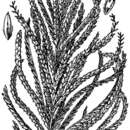Comprehensive Description
provided by North American Flora
Leptochloa scabra Nees, Agrost. Bras. 435. 1829
Leplochloa Langloisii Vasey, Bull. Torrey Club 12: 7. 1885. (Type from Louisiana, Langlois.) Leptochloa Liebmanni Foum. Mex. PI. Gram. 2: 147. 1886. (Type from Antigua, Mexico, Liebmann 248.)
Annual; culms stout, erect, branching, usually more than a meter tall; sheaths glabrous or scaberulous, rounded on the back, usually shorter but sometimes longer than the internodes; ligule ciliate, 1-2 mm. long; blades flat, lax, 10-45 cm. long, 6-14 mm. wide, scabrous; inflorescence 20-35 cm. long; spikes numerous, crowded, fiexuous, spreading, the lower mostly 6-8 cm. long, the upper one somewhat shorter; spikelets 3-4-flowered, 3-4 mm. long; glumes acute or acuminate, 1-nerved, the first 1 mm. long, the second 1.5 mm. long; lemmas 2 mm. long, acute or minutely lobed, mucronate, pilose on the lower half of the midnerve and margins.
Type locality: Par4. Brazil.
Distribution: Swamps, Louisiana; Tabasco; West Indies, and southward to Peru and Brazil.
- bibliographic citation
- Albert Spear Hitchcock, Jason Richard Swallen, Agnes Chase. 1939. (POALES); POACEAE (pars). North American flora. vol 17(8). New York Botanical Garden, New York, NY
Physical Description
provided by USDA PLANTS text
Annuals, Terrestrial, not aquatic, Stems trailing, spreading or prostrate, Stems nodes swollen or brittle, Stems erect or ascending, Stems mat or turf forming, Stems caespitose, tufted, or clustered, Stems terete, round in cross section, or polygonal, Stems compressed, flattened, or sulcate, Stems branching above base or distally at nodes, Stem internodes hollow, Stems with inflorescence less than 1 m tall, Stems, culms, or scapes exceeding basal leaves, Leaves mostly cauline, Leaves conspicuously 2-ranked, distichous, Leaves sheathing at base, Leaf sheath mostly open, or loose, Leaf sheath smooth, glabrous, Leaf sheath hairy at summit, throat, or collar, Leaf sheath or blade keeled, Leaf sheath and blade differentiated, Leaf blades linear, Leaf blades 2-10 mm wide, Leaf blades 1-2 cm wide, Leaf blades mostly flat, Leaf blade margins folded, involute, o r conduplicate, Leaf blades mostly glabrous, Leaf blades scabrous, roughened, or wrinkled, Ligule present, Ligule an unfringed eciliate membrane, Inflorescence terminal, Inflorescence solitary, with 1 spike, fascicle, glomerule, head, or cluster per stem or culm, Inflorescence a panicle with narrowly racemose or spicate branches, Inflorescence branches more than 10 to numerous, Inflorescence branches 1-sided, Flowers bisexual, Spikelets sessile or subsessile, Spikelets laterally compressed, Spikelet less than 3 mm wide, Spikelets with 2 florets, Spikelets with 3-7 florets, Spikelets solitary at rachis nodes, Spikelets all alike and fertille, Spikelets bisexual, Spikelets disarticulating above the glumes, glumes persistent, Spikelets disarticulating beneath or between the florets, Spikelets secund, in rows on one side of rachis, Rachilla or pedicel glabrous, Glumes present, empty bracts, Glumes 2 clearly present, Glumes distinctly unequal, Glumes shorter than adjacent lemma, Glumes keeled or winged, Glumes 1 nerved, Lemmas thin, chartaceous, hyaline, cartilaginous, or membranous, Lemma 3 nerved, Lemma body or surface hairy, Lemma apex acute or acuminate, Lemma awnless, Lemma straight, Palea present, well developed, Palea membranous, hyaline, Palea about equal to lemma, Palea 2 nerved or 2 keeled, Stamens 3, Styles 2-fid, deeply 2-branched, Stigmas 2, Fruit - caryopsis.

